Ruchira tells us about weddings in Andhra Pradesh, in the weekly column, exclusively for Different Truths.
Nearly four years ago, along with my family, I had flown down to Hyderabad to attend…yes you have guessed right … a typical traditional elaborate Telugu (read Brahmin) wedding. And trust me it was an eye opener, an experience of a lifetime for us who belong to another culture. Now, looking back I was tempted to jot down my experiences in this column.
In Andhra Pradesh, each caste has its own customs. The upper castes engage Brahmins to perform the ceremonies, while lower castes engage non-Brahmins. For Andhraites pendli or wedding is considered the strongest of social bonds. In the process two souls are merged, thereby opening the gateway to gruhastaashramam (household life) as described in the scriptures. Telugu folks believe that marriage is a family union rather than an individual formality.
A Telugu wedding kick starts with Nischitartham or engagement. The two families meet to perform rituals and later make the engagement official. A muhūrtaṃ (auspicious date and time) for the wedding is decided based on the pair’s horoscopes. The people of Andhra scrupulously avoid Shunya maasam i.e., certain phases in the months of Aashaadham, Bhadrapadam as these are considered inauspicious for the ceremonies. The couple (especially the bride) is blessed by elders of both families, and are showered with gifts by way of gold jewellery, silverware, dresses, et al by their prospective new families.
A ritual termed Snatakam (literary meaning graduation) is usually performed. The groom is ceremonially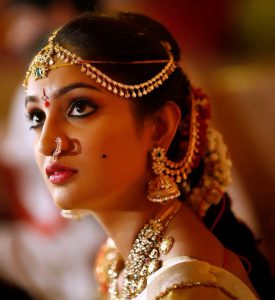 assigned all the family responsibilities and householder’s duties. This takes place at the bridegroom’s residence before the muhūrtam. The groom is asked to wear a silver thread on his body. This is followed by a unique (a tad comical) ritual known as Kashi Yatra. During the ceremony, the groom pretends to leave home for Kashi, on the pretext that he is fed up with mundane worldly life. Family ties and interpersonal relationships hold no charm for him. At this juncture, a brother (0r a male cousin) of the bride steps in to bring the situation under control. He coaxes and cajoles the groom to change his mind for the sake of his sister. After a great deal of banter, teasing and frolic the groom to finally change his mind. Now here are a few salient features of Telugu wedding. The bride-to-be’s maternal uncle and her brother play key roles throughout the ceremonies. Secondly, the religious ceremonies begin around midnight and end before sunrise – a clear deviation from the wedding styles in most Indian states.
assigned all the family responsibilities and householder’s duties. This takes place at the bridegroom’s residence before the muhūrtam. The groom is asked to wear a silver thread on his body. This is followed by a unique (a tad comical) ritual known as Kashi Yatra. During the ceremony, the groom pretends to leave home for Kashi, on the pretext that he is fed up with mundane worldly life. Family ties and interpersonal relationships hold no charm for him. At this juncture, a brother (0r a male cousin) of the bride steps in to bring the situation under control. He coaxes and cajoles the groom to change his mind for the sake of his sister. After a great deal of banter, teasing and frolic the groom to finally change his mind. Now here are a few salient features of Telugu wedding. The bride-to-be’s maternal uncle and her brother play key roles throughout the ceremonies. Secondly, the religious ceremonies begin around midnight and end before sunrise – a clear deviation from the wedding styles in most Indian states.
The main wedding rituals begin with Maṅgaḷa Snānaṃ. The bride and groom are required to take an auspicious bath on the wedding day. Thus cleansed and purified they are now entitled to perform the solemn rituals. The next step is the ceremonial make-up and is conducted in the respective homes of the bride and groom. Relatives and family members gather to smear the very important pair with turmeric paste, Nalugu (a mixture of flour and turmeric powder) and oils. In modern connotation, this is nothing but a Spa cum facial treatment rolled into one. The pair is given a new set of clothes to wear and are ceremoniously blessed, with an eye on their future life together. Once this ceremony is over the bride is not allowed to go out of the house until the wedding rituals are completed. In the next phase, the couple is given a ceremonial oil bath, following which their Arati is performed by the womenfolk.
Next, the groom participates in the Ganesha and Gowri pooja, which is conducted at the mandapam i.e., the wedding venue. The idea is to propitiate the deities in order to secure a blissful and harmonious 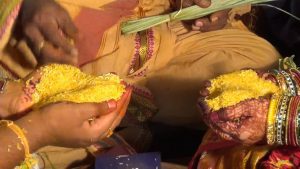 conjugal life. The bride on her part performs the Gauri Pūja at the house along with all family members and loved ones. It is during this time that Pravara, the ritual of changing the Bride’s gotram (family lineage) from her native one to that of the groom is performed. It is mandatory for elderly couples from both families to attend the Pravara ceremony. The crux of the wedding is Kanyādānam wherein the girl’s family hands over their daughter’s responsibility to the groom. For this, a maternal uncle brings the bride – ensconced in a basket – to the mandapam. At this point in time, the bride and groom are not allowed to look at each other. Even though they are seated opposite each other a cloth curtain is placed between them. Thereafter, the bride’s parents wash the groom’s feet. The reason being, on the day of the wedding the bridegroom is considered, “Lord Vishnu Svarūpaṃ” (incarnation of Lord Vishnu) who has come to marry their daughter – who symbolises Devi Lakshmi. The groom chants “Dharmēcha Arthēcha Kamēcha Mokshēcha Nāti Charāmi” thrice thereby assuring the bride’s father that he will remain her companion in joy and sorrow till death do them part….For the next ritual Panigrahanam, the groom clasps the bride’s hand. He then utters a solemn pledge: The Devas have offered you to me in order that I may live the life of a householder (Gruhasta); we shall not part from each other. Now is the time for yet another important significant ritual. Jīlakarra Bellamu. Accompanied by the recitation of shlokas from the Vedas, the couple is asked to place a handful of cumin seeds and jaggery paste on each other’s head. This signifies that duo’s relationship ought to be as inseparable as the two ingredients which are of the same colour. The Pravara is performed once more in the presence of the groom and the guests. For the Madhuparkam ritual that follows, the bride wears a white sari with a red border while the groom is clad in a white dhoti with a red border. White symbolizes purity and red strength. She is surrounded by ten Sumangalis (elderly women with long blissful matrimonial innings).
conjugal life. The bride on her part performs the Gauri Pūja at the house along with all family members and loved ones. It is during this time that Pravara, the ritual of changing the Bride’s gotram (family lineage) from her native one to that of the groom is performed. It is mandatory for elderly couples from both families to attend the Pravara ceremony. The crux of the wedding is Kanyādānam wherein the girl’s family hands over their daughter’s responsibility to the groom. For this, a maternal uncle brings the bride – ensconced in a basket – to the mandapam. At this point in time, the bride and groom are not allowed to look at each other. Even though they are seated opposite each other a cloth curtain is placed between them. Thereafter, the bride’s parents wash the groom’s feet. The reason being, on the day of the wedding the bridegroom is considered, “Lord Vishnu Svarūpaṃ” (incarnation of Lord Vishnu) who has come to marry their daughter – who symbolises Devi Lakshmi. The groom chants “Dharmēcha Arthēcha Kamēcha Mokshēcha Nāti Charāmi” thrice thereby assuring the bride’s father that he will remain her companion in joy and sorrow till death do them part….For the next ritual Panigrahanam, the groom clasps the bride’s hand. He then utters a solemn pledge: The Devas have offered you to me in order that I may live the life of a householder (Gruhasta); we shall not part from each other. Now is the time for yet another important significant ritual. Jīlakarra Bellamu. Accompanied by the recitation of shlokas from the Vedas, the couple is asked to place a handful of cumin seeds and jaggery paste on each other’s head. This signifies that duo’s relationship ought to be as inseparable as the two ingredients which are of the same colour. The Pravara is performed once more in the presence of the groom and the guests. For the Madhuparkam ritual that follows, the bride wears a white sari with a red border while the groom is clad in a white dhoti with a red border. White symbolizes purity and red strength. She is surrounded by ten Sumangalis (elderly women with long blissful matrimonial innings).
Six of them hold plates containing a sacred mixture of rice and turmeric powder, while the rest of them hold tiny, glowing lamps on their plates. Rice represents plenty while the lamps symbolize brightness Before the Mangalsutram ceremony the curtain between the bride and groom is dropped. The groom ties the two strings of Mangalasutram, each with a golden disc, around the bride’s neck with three knots. This denotes their physical, mental and spiritual union. During the Akshitalu or Talambralu ceremony, the bride and groom exchange garlands. Married elders and guests bless the couple by showering them with flower petals and rice coated with turmeric powder.
During the Saptapadi, the groom and bride walk seven steps together around the fire, while uttering the seven sacred vows: of love, duty, fidelity, commitment, et al. Among Telugu Brahmins the pallu (edge) of the bride’s sari is tied to one end of the groom’s Kanduva (scarf).
Now, it is time for Sthalipakam where the groom adorns his bride’s toe with a silver ring. The saying goes 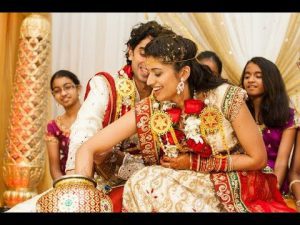 that the groom thus goes down on his knees before the lady in order to claim her as his own. To ward off the evil eye, the bride is adorned with a string of black beads during the ceremony. After this, a kunda (ornate silver/terra-cotta vessel) full of water is placed in front of the couple, and a ring is put in it. The groom puts in his right hand and the bride her left, together they hunt for the ring. Out of the three rounds whoever wins twice is likely to dominate the relationship in future. For the fun of it, the bride is made to cook a mock meal using a part of the sacred fire. This symbolises that she is now competent to look after her spouse and family. In the next ritual, the couple is shown two stars representing Arundhati and Vasistha. As per the Hindu scriptures, the mythical sage and his wife were considered the epitome of harmonious, peaceful matrimony.
that the groom thus goes down on his knees before the lady in order to claim her as his own. To ward off the evil eye, the bride is adorned with a string of black beads during the ceremony. After this, a kunda (ornate silver/terra-cotta vessel) full of water is placed in front of the couple, and a ring is put in it. The groom puts in his right hand and the bride her left, together they hunt for the ring. Out of the three rounds whoever wins twice is likely to dominate the relationship in future. For the fun of it, the bride is made to cook a mock meal using a part of the sacred fire. This symbolises that she is now competent to look after her spouse and family. In the next ritual, the couple is shown two stars representing Arundhati and Vasistha. As per the Hindu scriptures, the mythical sage and his wife were considered the epitome of harmonious, peaceful matrimony.
The wedding is rounded off with Appagintalu when the bride is physically handed over to the groom. After the bride arrives in her new abode, accompanied by her spouse, she is accorded ceremonial welcome chiefly by her mother-in-law and other close relatives. Her entry is usually followed by a Satyanarayana Pooja (worship of Lord Narayana/Vishnu), in a bid to seek domestic harmony and prosperity.
©Ruchira Adhikari Ghosh
Photo from the Internet
#TeleguWedding #IndianWeddings #WeddingsInIndia #MatrimonyRituals #HinduWeddings #SliceOfLife #DifferentTruths

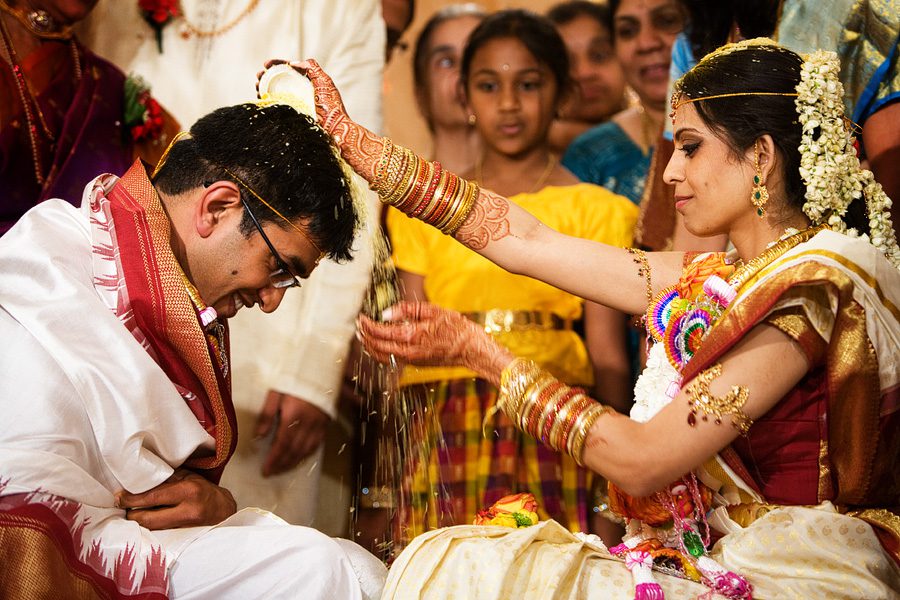
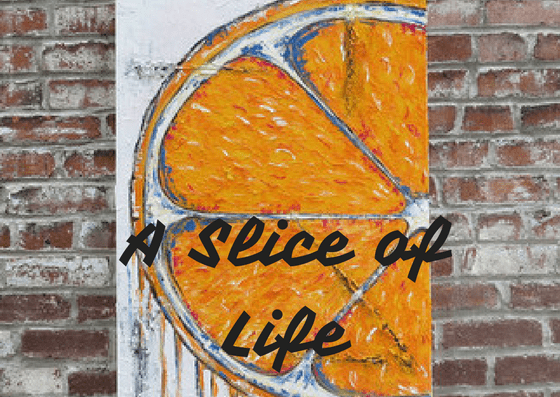

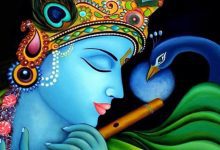
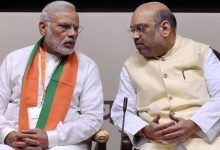


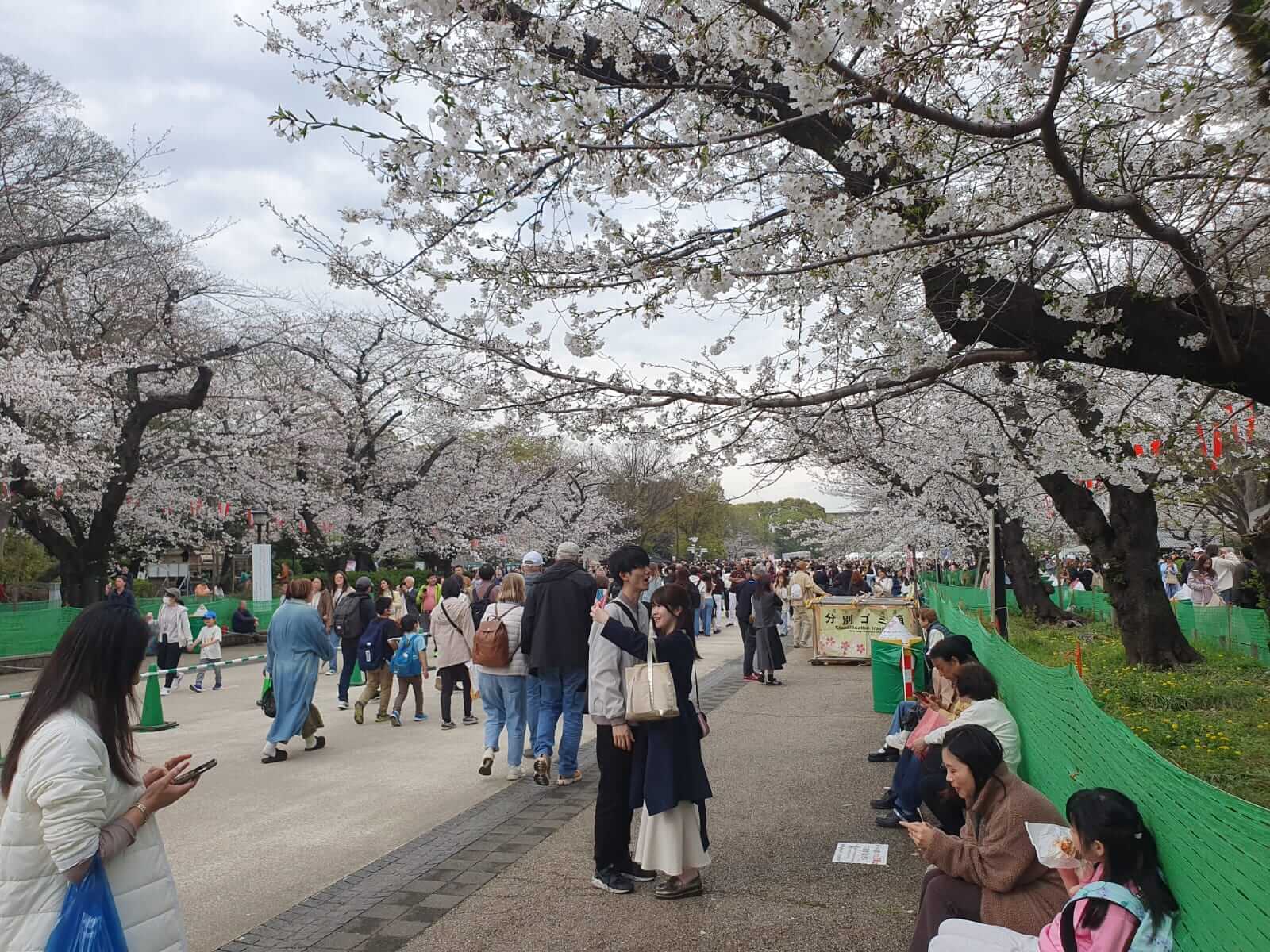

 By
By